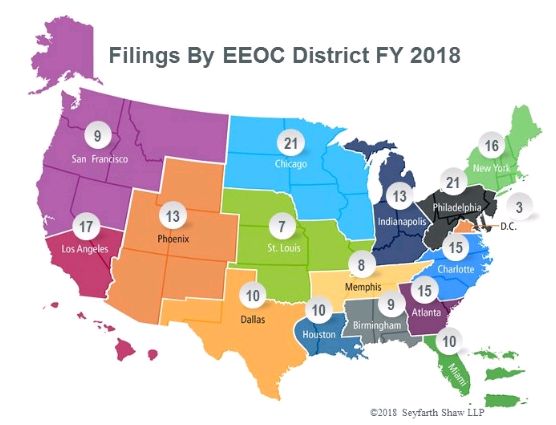Seyfarth Synopsis: The uncertainty of a new administration's impact on the EEOC that plagued FY 2017 is fading, but the results are not what some would expect. Not only has the EEOC brought a mountain of filings compared to the last four years, but also the agency has demonstrated a clear focus on sex-based discrimination and sexual harassment in the workplace in light of #MeToo, even surpassing FY 2017 numbers.
With a full fiscal year under its belt, the Trump Administration's impact on EEOC-initiated litigation is still uncertain. With two Republican Commissioners and the General Counsel position still unconfirmed, it is difficult to discern if things will truly be "business as usual" under Trump or if those appointments, once confirmed, will change agency course. One thing is certain: the EEOC's litigation program is not slowing down any time soon. Just as the waning months of FY 2017 showed a marked increase in filings, FY 2018 turned up the heat even more. Filings are up more than ever, with sex discrimination filings and #MeToo filings – i.e., complaints of sexual harassment – eclipsing previous years.
The total number of filings in FY 2018 demolished FY 2015 and 2016, and even surpassed FY 2017. (Compare here to here and here). This year, the EEOC filed 217 actions, 197 merits lawsuits and 20 subpoena enforcement actions.

Predictably, the EEOC waited until the last minute to push filings, with this past month showing the most filings compared to any other month this fiscal year. At the time of publication, 84 lawsuits were filed in September, including 45 in the last 3 days alone. Notable this year, however, was the "ramp up" period in June, July and August, which accounted for 63 of the total filings. Almost half of those cases were brought in August. The total filings for the remaining months remain low, with the number of filings in October through February failing to hit double digits.

Filings in Chicago, Philadelphia and Los Angeles continue to top the charts, with 21, 21, and 17 total filings, respectively. These numbers remain relatively consistent to FY 2017, which showed 21 filings in Chicago, 19 in Philadelphia, and 22 in Los Angeles. On the lower end, the St. Louis and Memphis numbers were modest, with only 7 filings in St. Louis and 8 filings in Memphis. Of the remaining districts, the Phoenix and New York district offices rebounded after a slow FY 2017, each filing 6 more lawsuits in FY 2018 as compared to last year.
Sex Discrimination Takes Center Stage
Each fiscal year we analyze what substantive theories the EEOC is targeting. This year, Title VII claims remained the largest category of filings, on par with FY 2017, which boasted 53% of all filings. In FY 2018, Title VII filings accounted for 55% of all filings. Although FY 2016 showed a dip in Title VII filings at 41%, this year's Title VII filings beat out FY 2015 and FY 2014 as well.

With a new Strategic Enforcement Plan in place to guide litigation activity for FY 2018-2022, many expected some shift in focus based on two notable changes from the old plan. Specifically, the new plan pledged to address discriminatory practices against those who are Muslim or Sikh, or individuals of Arab, Middle Eastern, or South Asian descent. Additionally, the new plan aims to expand the EEOC's equal pay priority to include compensation discrepancies for race, ethnicity, age, and disability – moving beyond the EEOC's focus on sex-based pay disparities. In fact, we have actually seen a decrease in Equal Pay Act filings, which could reflect the EEOC's renewed focus on equal pay issues that affect other protected groups, which would not fall under the jurisdiction of the Equal Pay Act.
One trend has emerged this year – compared to FY 2017, race filings have decreased by 6 filings – with 18 filings in FY 2018 compared to 24 filings in FY 2017.
Perhaps the most striking trend of all is the substantial increase in sex-based discrimination filings, primarily the number of sexual harassment filings. As predicted, #MeToo added fuel to this area of the EEOC's agenda, with 74% of the EEOC's Title VII filings this year targeting sex-based discrimination. Compare this to FY 2017, where sex based discrimination accounted for 65% of Title VII filings. Of the FY 2018 sex discrimination filings, 41 filings included claims of sexual harassment. 11 of those filings were brought in the last three days of the fiscal year alone. The total number of sexual harassment filings was notably more than FY 2017, where sexual harassment claims accounted for 33 filings.
EEOC's #MeToo Harassment Filing Surge

Implications For Employers
The dramatic increase in filings should be an eye-opener for employers in an era when many thought the EEOC might be hitting the brakes. Instead, the EEOC is increasing its enforcement activity, with a particular focus on sex discrimination and sexual harassment. The EEOC still strongly advises employers should update and aggressively enforce their EEO Policies. Now, more than ever, employers need to be on top of their game to avoid becoming the next target of EEOC-initiated litigation.
As most of our loyal readers know, this blog is merely a preview of the more extensive analysis of EEOC trends and developments affecting EEOC litigation that we publish at the end of the calendar year. Stay tuned for our in-depth analysis of FY 2018 filings, and particular danger areas for employers in this shifting political climate.
The content of this article is intended to provide a general guide to the subject matter. Specialist advice should be sought about your specific circumstances.




